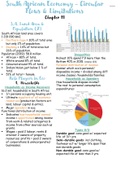Summary
Summary EKN120 Cht 11 - South African Economy: Circular flows and Limitations
- Course
- Institution
- Book
Content covered: - Role players in economy. - Circular flow diagram. - Societies economizing problem. - Production possibilities curve.
[Show more]



